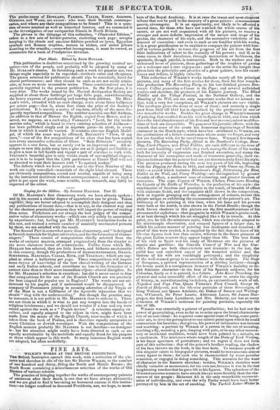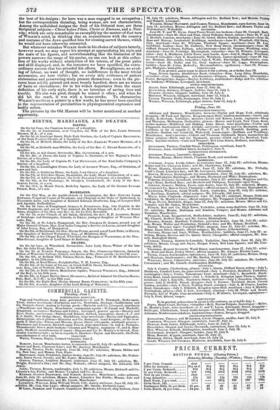FINE ARTS.
WILKIE'S WORKS AT THE BRITISH INSTITUTION.
Tat British Institution opened this week, with a collection of the pic- tures and sketches in oils of the late Sir DAVID %Late, to the number of one hundred and thirty, filling the North and Middle Rooms ; the South Room containing a miscellaneous selection of the works of Old Masters of various schools.
The practice of bringing together the works of contemporary painters of eminence after their death, is one that we have always advocated; and we are glad to find it becoming an honoured custom at this institu- tion—no longer confined to deceased Presidents, nor, we hope, to mem-
bers of the Royal Academy. It is at once the truest and most eloquent tribute that can be paid to the memory of a great painter : sinaantanentaas quceris, circumspice. It is an opportunity, not likely to be afforded a second time, for those who have not watched the whole course of his career, or are not well acquainted with all his pictures, to receive a, stronger and more definite impression of the nature and scope of his genius, the character of his style, and the successive variations of his manner of execution : and even to such as are familiar with bis works, it is a great gratification to be enabled to compare the painter with him- self at various periods ; to trace the progress of his art from the first faint indications of talent to the maturity of his powers ; and if, as in some cases, to their decadence, through mannerism or feebleness, the spectacle, though painful, is instructive. Both to the student and the. unlearned lover of pictures, these gatherings of the trophies of genius are a welcome and a rare enjoyment ; and to the artist the insight thus given into the principles and practice of a great painter, into his excel- lences and defects, is highly valuable.
This collection of WIIXIE'S works includes nearly all his principal, pictures, and many of the first studies for them, from his first remark- able production The Recruiting Party, to his last-finished picture Ben- renuto Cellini presenting a Crasser to the Pope; and several unfinished studies and sketches, the products of his Eastern journey. The Blind.
Fiddler and the Village Festival, in the National Gallery, and the Reading of the Will, are the only important works that we missed; so
that, with a very few exceptions, all WILKIE'S pictures are now visible.
The catalogue gives the dates of most of them ; and scarcely a single. year from 1805 till 1841 but is signalized by the production of one or
two remarkable works. Besides the great change iu WILKIE'S manner
of painting that resulted from his visit to Spain in 1828, and from which dates the total abandonment of his first and best manner, minor modifica- tions of both are discernible. We pass over his juvenile efforts, with the
remark that some of the crude but humorous depietu rings of Scottish character in the Dutch style, which have bee I attributed to WiLs.fe, are, the productions of a fellow -countryman whose name we forget, and very few are familiar with, for he never rose to fame. WILKIE'S first famous, pictures, The Recruiting Party, Alfred in the Neatherd's Cottage, Rent- Day, Card-Players, and Blind Fiddler, are each different in the tone of ' colour and handling ; and while they rank among the finest of his works,
both for intensity of expression and finished execution, and stamp the character of his conception and mode of treatment generally, their va- riations indicate that the painter had not yet determ Merely fixed his style.
The pictures produced during the next ten years of his life, beginning with the Digging for Rats, in 1811, and ending with Guess my Name, in
1821—a period which includes Blindman's Buff, DMtraining for Rent,
Rabbit on the Wall, and Penny Wedding—are distinguished by greater breadth of effect, a mellower tone of colouring, and greater freedom of
execution. The capo d'opera of WILKIE, Chelsea Pensioners Reading the Gazette of the Battle of Waterloo, is the perfection of his style: the combination of freedom and precision in the touch, of breadth of effect. with elaborate finish, and the exquisite skill shown in the composition, both as regards grouping and the arrangement of colours, render this_
picture unique as exhibiting the consummation of the painter's art. The brilliancy of his painting at this time, when his fame and his powers were both at the zenith, is also shown in the Parish Beadle; though the
dark brown shadows in this picture are the first manifestations of his proneness for asphaltum—that quagmire in which WIMEIE.13 genius sank,
or at best through which his art struggled like a fly in treacle. At this point, too, he left the miniature scale, which was exclusively adapted to his microscopic observation, and essayed figures of a larger size, to which his minute manner of painting was inadequate and unsuited : if
proof of this were needed, it is supplied by the fact that the faces of his life-size figures look less than nature, whereas in the finest pictures of the great Italian masters they appear larger than life. The best fruits- of his visit to Spain and his study of Meaux° are the pictures of monks and guerillas: the Guerilla Council of War and the Gue- rilla's Return are both characteristic and dramatic : in the last, the pallid hue and enfeebled aspect of the wounded soldier and the,
distress of his wife are touchingly portrayed ; and the simplicity of the well-massed group is in accordance with the subject. The Siege of Saragossa, a spirited representation of a stirring iuciJent—though the heroic maid is a conspicuous instance of Work's inability to de- pict feminine character—is the best of his Spanish subjects; for his Columbus, finely as it is painted, is a failure. John Knox Preaching, the greatest and most successful effort of the painter to attain the dignity of history, is, notwithstanding its defects, an extraordinary work of art. Napoleon and Pope Pius, Queen Victoria's First Council, George the Fourth at Holyrood, and the life-size portraits of these Sovereigns, of King William and Queen Adelaide, the Dukes of Sussex and Welling-
ton, O'Connell, Sir Peter Laurie, Alderman Lucas, Sir James Mac- gregor, the first Lady -Lyndhurst, and Mrs. Maberly, are but so many evidences of WILKIE'S unfitness for painting portraits, especially the size of life.
Witaus was essentially a painter of peculiarities; but he had not the power of generalizing, even so far as to seize upon the broad characteris- tics of an individual : he required some special state of being, some parti- cular act, to rivet his perceptions to one salient point upon which he could concentrate his faculties ; that given, his power of delineation was intense and unerring: a portrait by Wu.xim of a person in the act of sneezing, catching a fly, mending a pen, limping with pain, or in any other momen- tary or accidental condition, would have been painted to a miracle, on a small scale. The miniature whole-length of the Duke of York Writing, is his finest specimen of portraiture ; and we regret it does not form part of this collection : that of the painter's brother reading, the shadow of bis face thrown on the book, is the best here. To instance proofs of this singular talent in his popular pictures, would be to enumerate almost every figure in them ; for each one is characterized by some peculiar sensation, or engaged in doing something. This accounts for the want of character in his Eastern sketches: besides, Weexta's sketches were chiefly valuable as memoranda for his own use, because it was in the last heightening touches that he gave life to his figures. The splendour of the - Oriental costume seems to have struck his eye more forcibly than the cha- racters of the people; Mehemet Ali is the only remarkable represent-
ation of individuality, and even the wily Pacha would have been better' portrayed by him in the act of smoking. The Turkish Letter- Wrster is . the best of his designs ; for here was a man engaged in an occupation ; but the correspondents dictating, being women, are not characteristic. Among the unfinished designs the fruit of his Oriental tour, are three Scriptural subjects-Christ before Pilate, Christ at Emmaus, and a Nati- vity which are only remarkable as exemplifying the matter-of-fact turn of ILKIE'S mind, in thinking that an acquaintance with the country and costume of the Jews qualified him for treating sacred themes, which he would not have otherwise attempted.
But whatever mistakes WILIUE made in his choice of subjects latterly, however much we may regret his attempt at aggrandizing his style and the scale of his figures, and notwithstanding that the limitation of his powers narrows the range of his genius, no one can look at this collec- tion of his works without admiration of his talents, of the great pains and skill displayed, and, in the instances we have specified, the extra- onlinary success that has attended his efforts. No negligence, no evad- ing of labour, no want of thought, no indifference to the most trivial accessories, are here visible; but on every side evidences of patient elaboration and persevering study present themselves : even in the pic- tures least solidly painted and most loosely handled, there are no traces of haste or slovenliness; for in his widest departures from the exact definition of his early style, there is no intention of saving time and trouble. His aim was good, though he missed it often ; and when be did hit the mark, it was with a home-stroke. To characterize Wnaun's merits as a painter in a few words, he has never been excelled in the representation of peculiarities in physiognomical expression and bodily action.
The pictures by the Old Masters will be better mentioned at another opportunity.



























 Previous page
Previous page